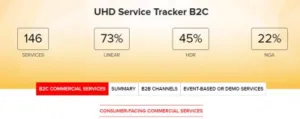The Ultra HD Forum has spent several years developing a UHD tracking service that they recently discussed in a wide-ranging webinar and panel discussion produced by the DVB (Digital Video Broadcast) organization. The database tracks over 150 commercial UHD service offerings with 21 fields of data, although not all are visible to the public on their web site. There are many interesting ways to slice the data but one of my first revelations was that perhaps half of these UHD service still broadcast in standard dynamic range and a BT.709 color gamut – so not an HDR experience, just one with more resolution.

Database developer Ben Schwarz, Chair of the Ultra HD Forum Communications Working Group explained that developing what to track was more complex than originally thought. They looked at tracking channels, but realized this was more representative of offers and not demand. They looked at counting platforms, transponders and content titles, but these had issues as well. They finally settled on counting commercial services that a consumer could subscribe to, either via subscription fees or via taxes that provided free services.
Most of the effort was focused on tracking Business-to-Consumer (B2C) services but some Business-to-Business (B2B) services were captured as well along with event-based or demo services. As the image below illustrates, the service shows there are 146 B2C services, 73% of which are linear, serving over 125 million viewers. The other quarter of VoD-based UHD services serve 180 million viewers. The data also shows that only 45% of these services offer HDR capability and 22% offer Next Generation Audio (NGA). However, Schwarz admitted in the webinar that they need to update the fields for NGA to make it clearer if a service is using an NGA codec vs. if they actually deliver NGA audio.
![]()
A large number, 52%, still use the BT.709 color space with a mix of networks over which services are delivered (cable, CATV, DTH, IPTV, OTT or terrestrial).
The tracker also seeks to quantify how many subscribers get these UHD services, estimating that 10% of the 3 billion subscribers worldwide now can receive these tracked services (300M). A column called Reach gives a rough indicator as to the number of subscribers (1 to 5 stars) each service has to help identify the scale of the service. What the database does not show is the scale of content to help differentiate a service that loops a small amount of content vs. one with a large variety of content.
The UHD Forum also announced the release of Version 2.3 of its Guidelines. The Guidelines use the concept of a “foundation layer” of readily available mature technologies, and an “enhancement layer” including newer, more leading-edge technologies. Throughout five years of Guidelines development, more than 35 member companies have contributed to the effort. (CC)

